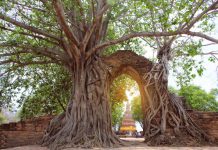
Wat Yai Chai Mongkol, the holy memorial site of the great king of Ayutthaya
From past to present, Thai society, locally has a temple as the center of faith, tradition, culture, and life. The symbolic temple is more than a religious place but also as the mutual property of the community. Undoubtedly, the importance of the Buddhist monastery toward Thai society projected through more than 30,000 temples nationwide. On the other hand, the temple is another famous tourist attraction which drawing lots of travelers from all direction in both domestic and abroad to appreciate the beautiful art and architecture. And many of them considered the historical site that has lasted with the Thai society for over the centuries. Noticeably, from the cradle to the grave, the strong attachment between temple and Buddhist in Thai society is a unique way of life whether the time goes by, unconditionally.
Well, in the old capital of Thailand ‘Ayutthaya’, abundant Buddhist holy sites which mostly are precious in historical and cultural value. And another famous ancient temple in Ayutthaya ‘Wat Yai Chai Mongkol’ that considered one of the most important temples in term of the history and also a must-see site attracting more than thousands of tourists annually to visit the temple. As top in mind tourist attractions of Ayutthaya city, Wat Yai Chai Mongkol, regularly, crowded with the visitors and Buddhist believers daily to experience the significant historic site. Distinctive in its architecture, the grand pagoda of Wat Yai Chai Mongkol is a real highlight of this holy place; furthermore, it recognized as the tallest pagoda in Ayutthaya province, as well. The rear of the monastery compound is the Shrine of King Naresuan the Great for the devotees to pay respect to one of the great kings in the Ayutthaya Kingdom. Besides, the lovely small park giving the shade and pleasant atmosphere to the complex. So, the temple is true must-not-miss to check-in for the tour in this ancient capital, indeed.
Knowing Wat Yai Chai Mongkol
As one of the famous old Buddhist temples since the Ayutthaya Kingdom, Wat Yai Chai Mongkol was established in the early Ayutthaya that is the reign of King Ramathibodee I or better known in another name “King U-Thong,” the founder of the Ayutthaya Kingdom. Mentioned with the mythology noted that King U-Thong, in 1357, graciously ordered to exhume the body of Prince Kaew who expired from cholera for cremation. And the venue of the cremation, later, set up the holy place called “Wat Pa Kaew.”
Afterward, the temple became faithful among the citizen of Ayutthaya since the group of monks at the temple studied the Dharma from Rattana Maha Thera in Sri Lanka. Consequently, lots of Buddhist ordained at Wat Pa Kaew increasingly. Therefore, King U-Thong appointed the Lord Abbot of this sect of the Buddhism at this temple to ‘Somdet Phra Wannaratana” which titled as the Supreme Patriarch or Sangkharaja of the right sect (Aranyawasi means the forest dweller) together with ‘Somdet Phra Phuttha Kosajarn”, the Supreme Patriarch of the Kamawasi (city monk).
Anyhow, the significant incident related to the history of Wat Pa Kaew is the ubosot of this temple was the meeting point of the secret society for the conspiracy to eradicate Khun Worawongsathirat and Nang Phraya Maeyuhua Sri Sudachan. Once, the mission accomplished, and then they invited Prince Thianracha (who was in the monkhood at that time) to succeed the throne with the title “King Maha Chakkraphat” of Suphannaphum Dynasty.
And in 1561, the throne of King Maha Chakkraphat”, the king commanded to execute the Supreme Patriarch of Wat Pa Kaew caused by the allegation to pick the auspicious day for the Prince Sri Silp’s rebellion.
However, in the reign of King Naresuan, the monastery served as the dwelling for Somdet Phra Wannaratana who was worshipful by King Naresuan. According to the history, during the fight on the elephant to Prince Minyekyawswa of Burma, King Naresuan was furious regarding the slow march of his armed forces. So, the king considered to put them to death. However, the venerable Somdet Phra Wannaratana asked for the life of those soldiers with the stratagem about the story of Buddha. Also, the notable monk gave the suggestion to the king to create the pagoda instead of execution. Thence, King Naresuan agreed with the idea and ordered to constructed the great stupa and named to “Phra Chedi Chai Mongkol” in 1592 with about 40 meters in height and 2 meters in width. The pagoda at Wat Yai Chai Mongkol accepted the tallest pagoda in Ayutthaya region from that time on.
Unluckily, Wat Pa Kaew or Wat Chao Tai was deserted upon the failure of Ayutthaya. Previously, in 1766, the Konbaung troop advance the army to Ayutthaya city, Phra Thinang Suriyat Amarin or better known as King Ekkathat, the last monarch of the Ayutthaya Kingdom ordered to march the navy force from the capital to set up at Wat Pa Kaew. Unfortunately, the Thai navy was tricked by the enemy, and the commander was killed. The Burmese army then seized part of the temple as the headquarters and once the Ayutthaya lost in the battle in 1767 the temple was abandoned at last.
The Renewal of the Monastery
After Wat Yai or Wat Pa Kaew or Wat Chao Tai was deserted for more than the centuries, a group of ascetics, including monks, novices, and nuns entered the property to open up the old temple to be the pilgrimage site. Finally, the fallow holy place turned to be a temple with the monks to reside at the compound in 1957 and named as “Wat Yai Chai Mongkol“. The temple has been renovated and developed continually until it accepted as one of the most significant developed monasteries of the Ayutthaya province, presently.
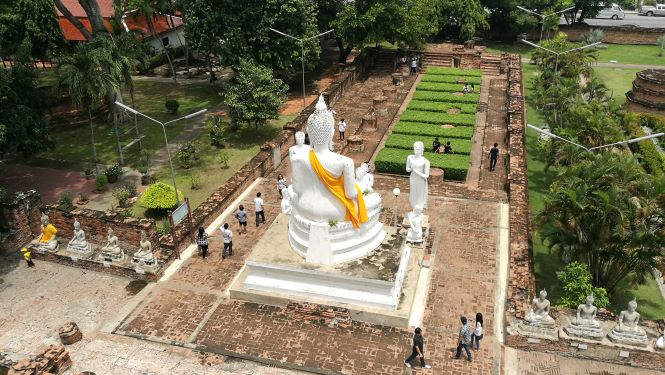
The highlight of Wat Yai Chai Mongkol
1. Chai Mongkol Chedi
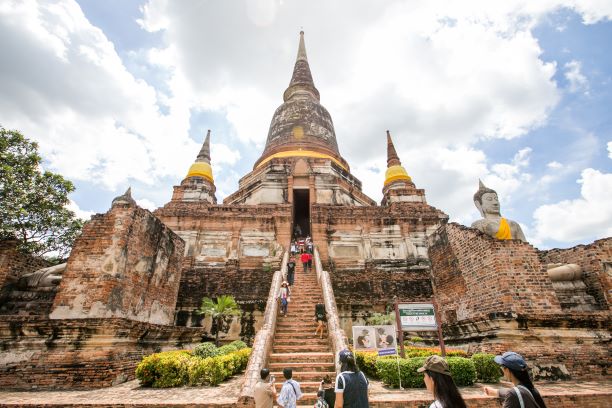
The memorial of the remarkable conquest of King Naresuan the Great in the significant battle to Minyekyawswa, the crown prince of Burma at Nong Sarai sub-district in Suphanburi province. At the time, Burma moved out the troop come up against the boundary of Ayutthaya Kingdom; hence King Naresuan and his younger brother Prince Ekatotsarot (the title at that time) advanced the army to fight the enemy. At the battlefield, the king rode on the significant elephant and besieged inside the adversary who mobilized the gun toward the king and his carrier. Noteworthy, the armed forces could make to follow the king on time. The king then roaring defied the prince of Burma that “Well, how come my brother stays in the shade of trees? Please come to join the battle as the honor to land as there’s no the future king to make the war elephant. What say you? Thence, Minyekyawswa pushed the elephant to fight, and King Naresuan sent the viceroy of Burna to death by cutting down across the chest with the sword “The Saen Phonlaphai.”
When King Naresuan and his armed force returned to the city, the king intended to amerce the soldiers delayed to follow him in the battle by regulation which the maximum penalty is “execution.” While the mishap soldiers were waiting for the punishment, Somdet Phra Wannaratana, the Supreme Patriarch together with 25 monks came to request absolution for those soldiers. The high priest offered a reason that metaphor the monarch is like the Lord Buddha environed by the demons before the enlightenment. And sparing the life would proclaim the king’s honor and bravery widely throughout the Kingdom.
Thus, King Naresuan agreed with the Supreme Patriarch and commanded to construct the great pagoda as the symbol of the victory and kindness of the great king of Ayutthaya. The remarkable pagoda was named by the king to “Chai Mongkol Chedi.”
2. Ubosot of Wat Yai Chai Mongkol
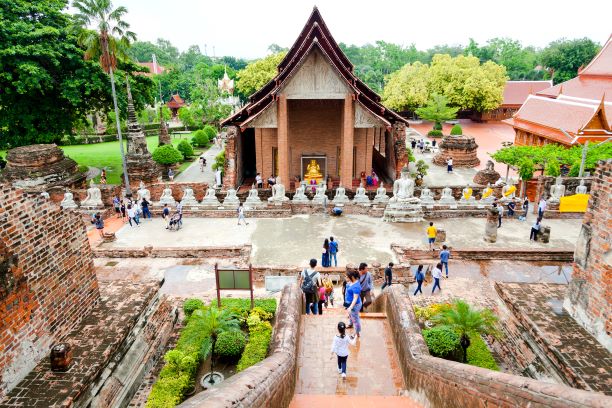
The building built in the reign of King U-Thong served as the meditation practice site, as well as the venue to practice the religious rites and ceremonies. In the past, the ordination hall was used as the meeting point of the secret group led by Khun Phirenthep and the party. They gathered here to cast the lots by candle to act the conspiracy to subdue Worawongsathirat and Si Suda Chan who governed the kingdom of Ayutthaya at that time. The cast was done by choosing 2 candles, one represented to Worawongsathirat (a so-called king of the Ayutthaya Kingdom which many of the scholars do not include him as the monarch) and another was Prince Thianracha, the descendant of the crown who avoids the rivalry to the throne by entering to the monkhood at Wat Ratpraditthan. The candle of Worawongsathirat blew out before the prince one which claimed the success of the mission.
Interior of the ubosot are many statues of the Buddha, and the most important one which is the main image in this hall is outstanding characteristic to others as it is the sandstone entirely. The robe of the Buddha lacquered and gilded and furnished with the fabulous glass work, while other parts of the statue revealed the delicate sandstone texture. The particular Buddha statue was created in the age of King U-Thong in the attitude of subduing Mara that is the famous posture of the main Buddha image.
3. The Sanctuary of the Reclining Buddha
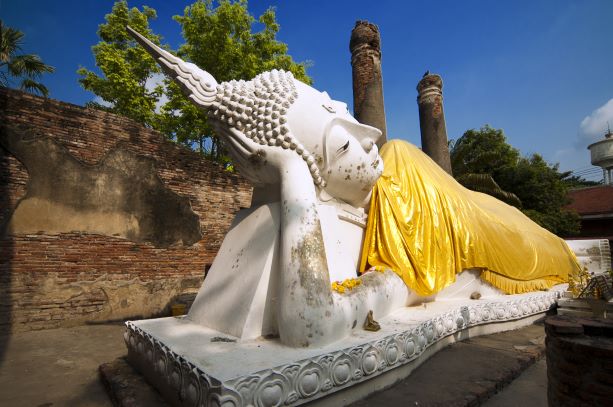
Walking through the path leading to the vihara (sanctuary) where the house to store the reclining Buddha statue that created in the throne of King Naresuan the Great. The image hall was used as the venue to practice the worship of the sacred images and meditation practice. The great Buddha image was repaired in 1965.
The building designed in the chapel structure and followed to the evidence presumed that it might be two entrances in the north of the building, unluckily they vanished. Inside the hall are four squared windows, the pillar is rounded shape with the trace of architrave at the top. The primary Buddha image faced to the east which is the front of the monastery complex and it already restored.
The tourist will enjoy photo shooting from this corner through the backward view that projected the great pagoda “Chai Mongkol Chedi” stands elegantly on the ground. And if you continue the walks, you will meet the spirit shrine called “Chao Pho Sitthichai Shrine” on the left.
Furthermore, the monastery also set up King Naresuan Shrine that completed the construction in 2001, too.
Regarding the tourism, Wat Yai Chai Mongkol considered one of the most beautiful temples with the fascinating and exotic architecture of the art. Also, the great pagoda ‘Chai Mongkol Chedi’ in Ayutthaya design that has stood stately from past to present.
Whether the ordination hall where housed ‘Phra Buddha Chai Mongkol,’ the main Buddha image of the temple, the giant reclining Buddha, or the grand pagoda are all the photogenic corner for the visitors to snap the shots and learn the history of the Ayutthaya Kingdom. So, it could say that Wat Yai Chai Mongkol is the ideal location for the traveler who loves in the beauty of history, indeed.
Taking the tour at Wat Yai Chai Mongkol is perfect in the morning time with the pleasant climate and fresh air. It is time the tourist will experience the simple way of life of the residents and stroll around the site comfortably with not much of the crowd.
How to get to Wat Yai Chai Mongkol
The temple opens to the public every day between 8.30am – 4.30pm. Specifically, the foreign tourist will be charged at THB20 per person.
And the trip to go to the temple, from Bangkok metropolis, drives on the highway number 32 and turn left at the intersection to enter Ayutthaya Town. And go straight on to Chedi Wat Sam Pleom Circle and keeps the left fork in about 1.5 km more. The temple is on the left.
And for public transport, the tourist once arrived at Ayutthaya Town, you can take the tricycle or picked up truck service to the site.


